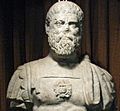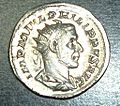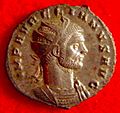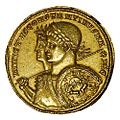Roman Dacia facts for kids
Quick facts for kids Provincia DaciaἘπαρχία Δακίας |
|||||||
|---|---|---|---|---|---|---|---|
| Province of the Roman Empire | |||||||
| 107–275 | |||||||
 Roman province of Dacia (125 AD) |
|||||||
| Capital | Ulpia Traiana Sarmizegetusa | ||||||
| Historical era | Classical Antiquity | ||||||
|
• Annexed by Trajan
|
107 | ||||||
|
• Withdrawal by Roman Emperor Aurelian
|
275 | ||||||
|
|||||||
| Today part of | |||||||
The Roman province of Dacia on the Balkans included the modern Romanian regions of Transylvania, Banat and Oltenia, and temporarily Muntenia and southern Moldova, but not the nearby regions of Moesia. It was added to the Roman empire in its earliest days under the war of conquest by the Emperor Trajan, and was ironically—considering its wealth— the first of the Roman provinces from which Rome withdrew.
Images for kids
-
The Dacian Kingdom around 100 AD, before the Roman conquest
-
Trajan's Column in 1820
-
A captive Dacian, Capitoline Museums, Piazza del Campidoglio, Rome
-
The lower Danube in Roman times map by Gustav Droysen
-
The sanctuaries in the ruined Sarmizegetusa Regia, the capital of ancient Dacia
-
Emperor Hadrian (117–138), as depicted in the Antalya Museum
-
Bronze coin of the emperor Hadrian commemorating his visit to Dacia
-
Emperor Antoninus Pius (138–161)
-
Statue of Emperor Marcus Aurelius (161–180), on Piazza del Campidoglio, Rome
-
Emperor Pertinax (193). Statue found at Apulum. On display at the National Museum of the Union, Alba Iulia, Romania.
-
Emperor Septimius Severus (193–211). Marble bust from the Glyptothek in Munich.
-
Bust of Emperor Caracalla (211–217). Cast in the Pushkin Museum (Moscow) after original in Naples.
-
A sestertius minted to commemorate the province of Dacia and its legions
-
The amphitheatre at Ulpia Traiana Sarmizegetusa
-
Emperor Philip the Arab (244–249)
-
Emperor Aurelian (270–275)
-
Emperor Diocletian (284–305)
-
Emperor Constantine I (306–337)
See also
 In Spanish: Dacia (provincia romana) para niños
In Spanish: Dacia (provincia romana) para niños























